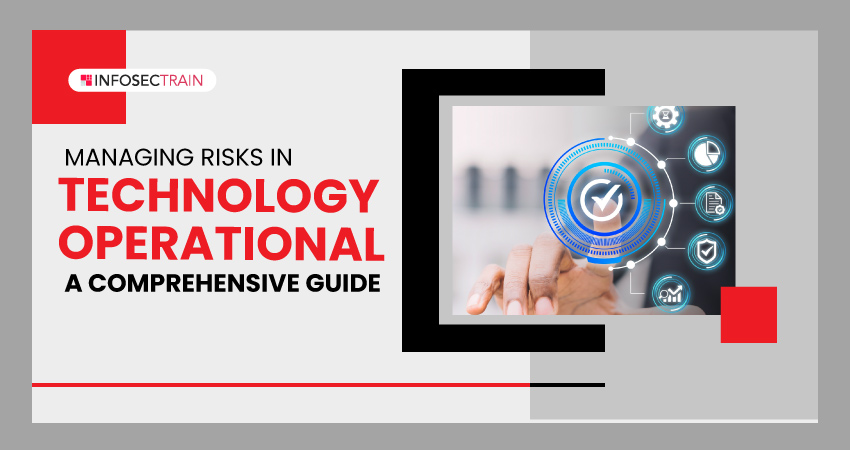Managing Risks in Operational Technology (OT): A Comprehensive Guide
In the age of digital transformation, Operational Technology (OT) plays a critical role in running various essential infrastructures. From power plants to transportation systems, OT systems are crucial to our vital operations’ safety, reliability, and continuity. However, as OT systems become more interconnected and digitized, they also become vulnerable to cybersecurity threats and potential risks.

Managing these risks is vital to ensure these critical operations’ safety, reliability, and continuity. This comprehensive guide aims to explore effective strategies and best practices to manage risks in OT environments.
Understanding the Risks in OT:
Before diving head first into risk management strategies, it is crucial to understand the diverse array of risks that can impact OT systems. These risks include cyber threats, physical attacks, insider threats, human error, system failures, and natural disasters. Each risk poses unique challenges and demands a tailored approach for mitigation.
1. Conduct a Thorough Risk Assessment:
Begin your risk management journey with a comprehensive risk assessment specific to your OT systems. Identify vulnerabilities, potential threats, and potential consequences. Engage with relevant stakeholders, including IT and OT teams, to understand the risks holistically. Regularly update the risk assessment to adapt to the evolving threat landscape and the evolution of your infrastructure.
2. Implement Strong Access Controls:
Enforce robust access controls for OT systems. Adopt Multi-Factor Authentication (MFA) to ensure only authorized personnel can access critical components. Utilize Role-Based Access Controls (RBAC) to limit privileges based on job roles. Regularly review and revoke unnecessary privileges to minimize the attack surface.
3. Segmentation and Network Isolation:
Employ network segmentation to separate OT systems from other networks, like corporate IT networks or the Internet. This segregation contains the impact of potential security incidents and prevents the lateral movement of attackers. Employ firewalls, access controls, and stringent network zoning for effective network isolation.
4. Regular Patch and Vulnerability Management:
Maintain a robust patch and vulnerability management process for OT systems. Regularly apply security patches and updates provided by vendors to address known vulnerabilities. Prioritize critical patches based on risk assessments and conduct periodic vulnerability scanning and assessments.
5. Establish a Comprehensive Incident Response Plan:
Prepare a detailed incident response plan tailored to OT environments. Define roles, responsibilities, and protocols for handling security incidents. Conduct regular drills and exercises to ensure all personnel are well-prepared to respond to potential threats promptly and effectively.
6. Educate and Raise Awareness:
Educate all employees, contractors, and third-party vendors with access to OT systems about cybersecurity best practices. Promote awareness about potential threats, social engineering techniques, and promptly reporting incidents. Foster a security-conscious culture to bolster your defense against potential risks.
7. Ensure Physical Security Measures:
Implement physical security controls to protect OT systems from unauthorized access or tampering. This includes access controls, surveillance cameras, intrusion detection systems, and secure physical locations for critical infrastructure components.
8. Vendor and Supply Chain Management:
Evaluate the security procedures of vendors and third-party suppliers involved in the OT ecosystem. Include security requirements and evaluations as part of the procurement process. Regularly review and monitor vendors’ security practices to ensure adherence to standards.
9. Develop Business Continuity and Disaster Recovery Plans:
Formulate comprehensive business continuity and disaster recovery plans for OT systems. These plans should include backup and restore procedures, redundant systems, and communication strategies to minimize downtime and ensure rapid recovery in case of an incident.
10. Stay Compliant with Regulations:
Stay updated on industry-specific regulations and standards relevant to OT systems. Ensure compliance with applicable requirements and establish processes to monitor and report compliance. Collaborate with regulatory bodies and industry associations to remain updated about emerging threats and best practices.
Conclusion:
Managing risks in OT environments is a complex and challenging task. However, by following the best practices mentioned in this guide, organizations can significantly reduce risk exposure and protect critical operations. A proactive and holistic approach that combines technology, processes, and employee awareness is essential to safeguard critical operations.
About InfosecTrain
InfosecTrain is a renowned security training organization that offers a wide range of IT security courses and services globally. Our OT/ICS Security Foundation Training is designed to equip candidates with the fundamentals of Operational Technology, enabling them to safeguard critical infrastructures effectively.
Join us now to take your OT security expertise to new heights!




 1800-843-7890 (India)
1800-843-7890 (India) 
